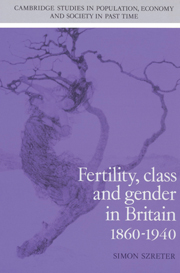Book contents
- Frontmatter
- Contents
- List of figures
- List of tables
- Acknowledgements
- List of abbreviations
- Introduction
- Part I Historiographical introduction: a genealogy of approaches
- Part II The professional model of social classes: an intellectual history
- Part III A new analysis of the 1911 census occupational fertility data
- Part IV Conceptions and refutations
- Appendices
- A Copy of 1911 census household schedule
- B Copy of sample pages from 1911 census Fertility of Marriage Report, Part 2, Tables 30 and 35 (respectively, the tabulations for incomplete and completed fertility for male occupations)
- C Male occupations rank ordered by completed fertility index, AM2/81–5
- D Male occupations: Industrial Orders and employment status variables
- E Male occupations rank ordered by incomplete fertility index, AM2/01–5
- F Male occupations rank ordered by AM25PC20 (the extent to which older-marrying couples restrict fertility more than younger-marrying couples)
- G Female occupations rank ordered by incomplete fertility index, AM2/01–5
- H Estimate of the scale of effect of differing infant mortality levels on reported fertility after 7.5 years of marriage
- Bibliography
- Index
- Cambridge Studies in Population, Economy and Society in the Past Time
H - Estimate of the scale of effect of differing infant mortality levels on reported fertility after 7.5 years of marriage
Published online by Cambridge University Press: 16 February 2010
- Frontmatter
- Contents
- List of figures
- List of tables
- Acknowledgements
- List of abbreviations
- Introduction
- Part I Historiographical introduction: a genealogy of approaches
- Part II The professional model of social classes: an intellectual history
- Part III A new analysis of the 1911 census occupational fertility data
- Part IV Conceptions and refutations
- Appendices
- A Copy of 1911 census household schedule
- B Copy of sample pages from 1911 census Fertility of Marriage Report, Part 2, Tables 30 and 35 (respectively, the tabulations for incomplete and completed fertility for male occupations)
- C Male occupations rank ordered by completed fertility index, AM2/81–5
- D Male occupations: Industrial Orders and employment status variables
- E Male occupations rank ordered by incomplete fertility index, AM2/01–5
- F Male occupations rank ordered by AM25PC20 (the extent to which older-marrying couples restrict fertility more than younger-marrying couples)
- G Female occupations rank ordered by incomplete fertility index, AM2/01–5
- H Estimate of the scale of effect of differing infant mortality levels on reported fertility after 7.5 years of marriage
- Bibliography
- Index
- Cambridge Studies in Population, Economy and Society in the Past Time
Summary
If it is assumed that the 1911 low-fertility occupations generally exhibited infant mortality rates (IMRs) of approximately 50 per thousand (see Appendix E) while the pre-1837 population exhibited a typical level of 150 per thousand (see Wrigley and Schofield, Population history, Table 7.19), the following simple calculation demonstrates the maximum likely scale of the effect of this difference in infant mortality on recorded fertility over the first 7.5 years of marriage.
The calculation is based on the following further assumptions.
(i) That both populations breast-fed for a full twelve months, giving the same exposure to the effect of lactational amenorrhoea.
(ii) That all the infant mortality occurred at the beginning of the first year of life. This is, of course, grossly unrealistic but it simplifies the calculation. As it will bias the outcome so as to overestimate the extent of the infant mortality effect, it does not call into question the conclusion reported in the text that the effect is exceedingly small; indeed, it substantially strengthens that conclusion.
(iii) According to Bongaarts's summary of the available evidence, twelve months' breast-feeding increases the period of postpartum infertility by an average of eight months (see above, ch. 8, n. 57). It has therefore been set in the calculation below that the birth interval is eight months shorter among those experiencing an infant death.
[…]
- Type
- Chapter
- Information
- Fertility, Class and Gender in Britain, 1860–1940 , pp. 634 - 635Publisher: Cambridge University PressPrint publication year: 1996



